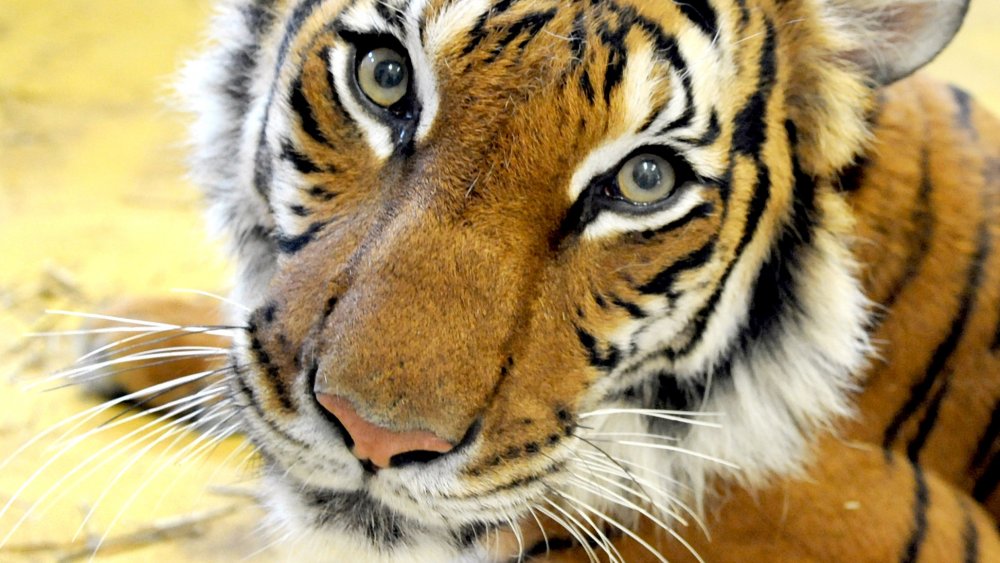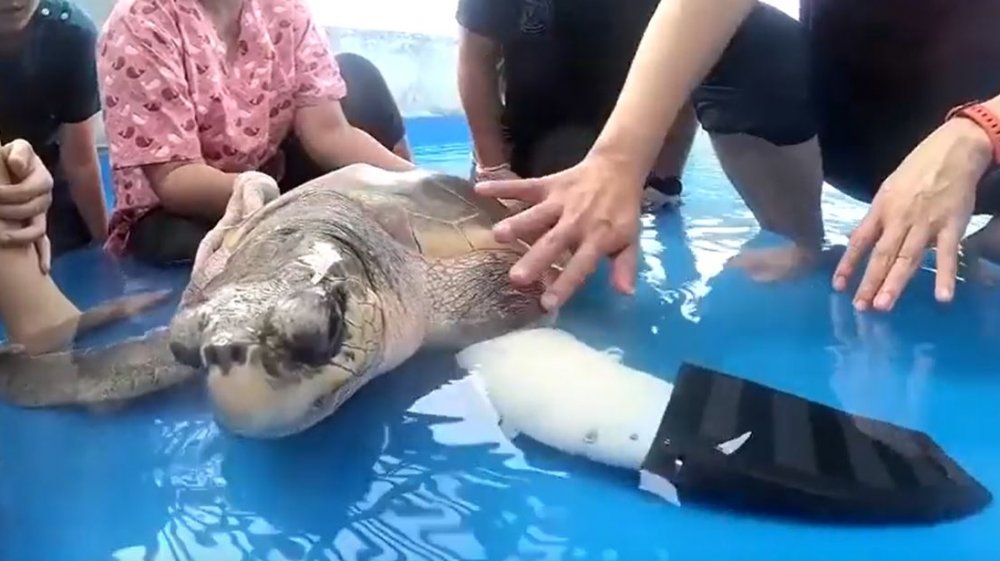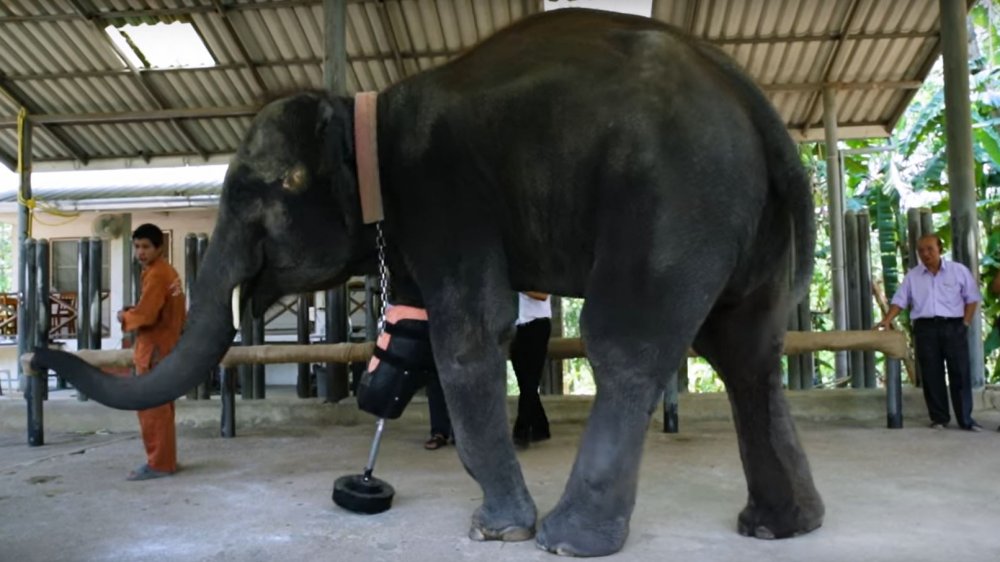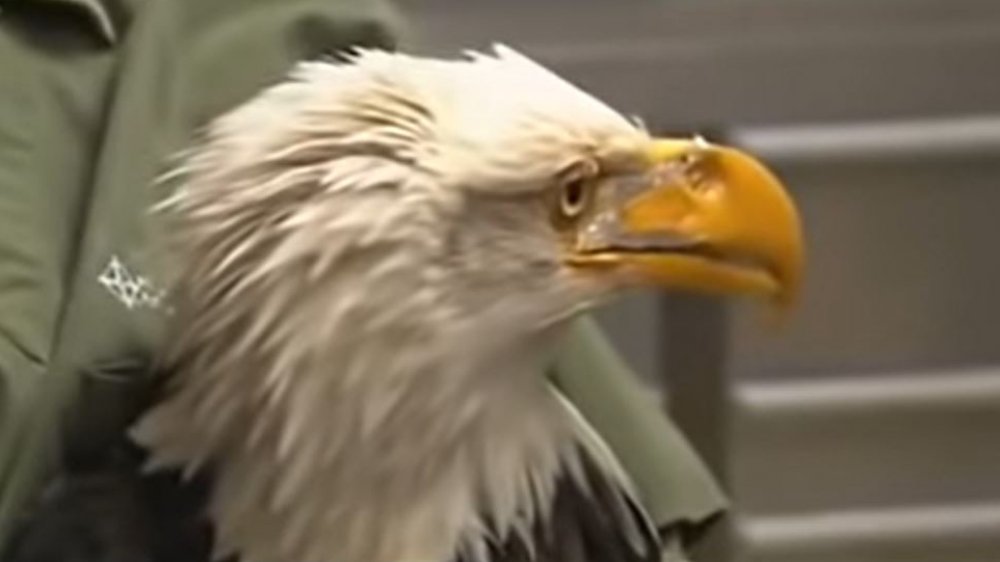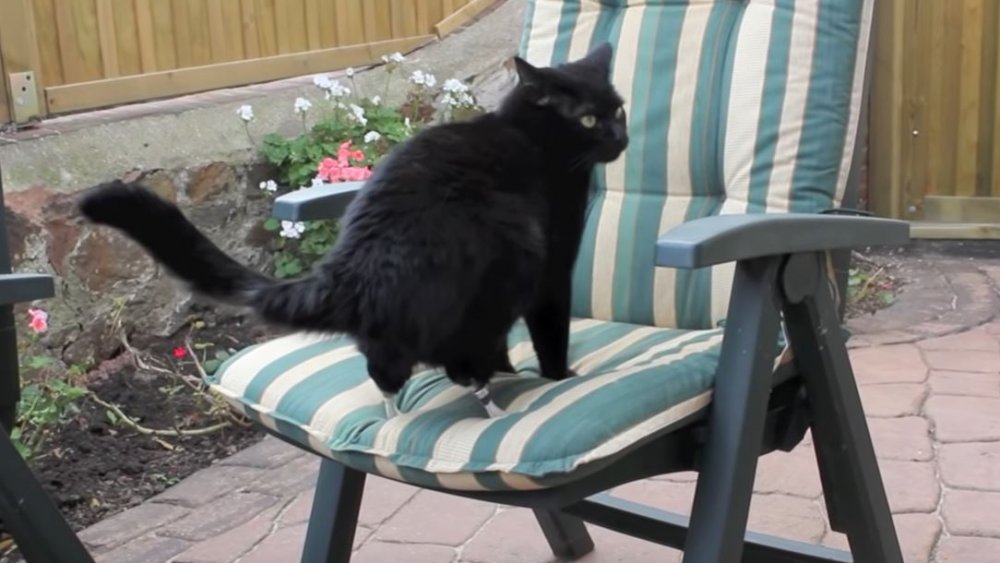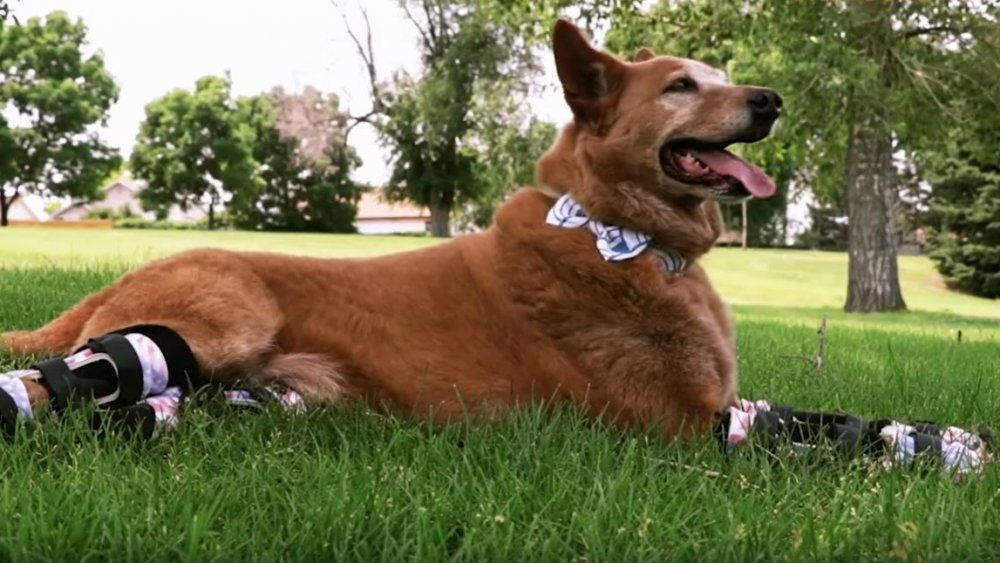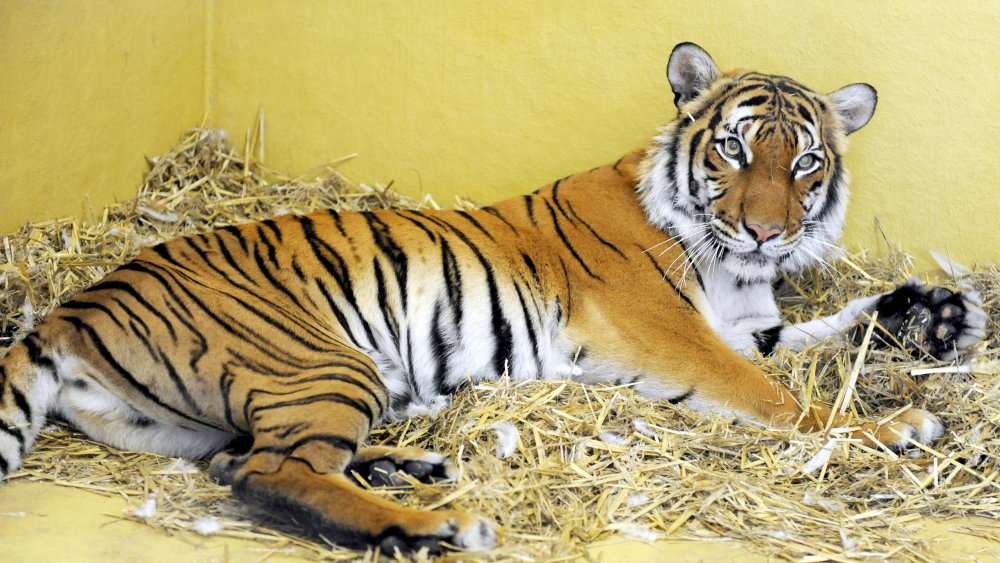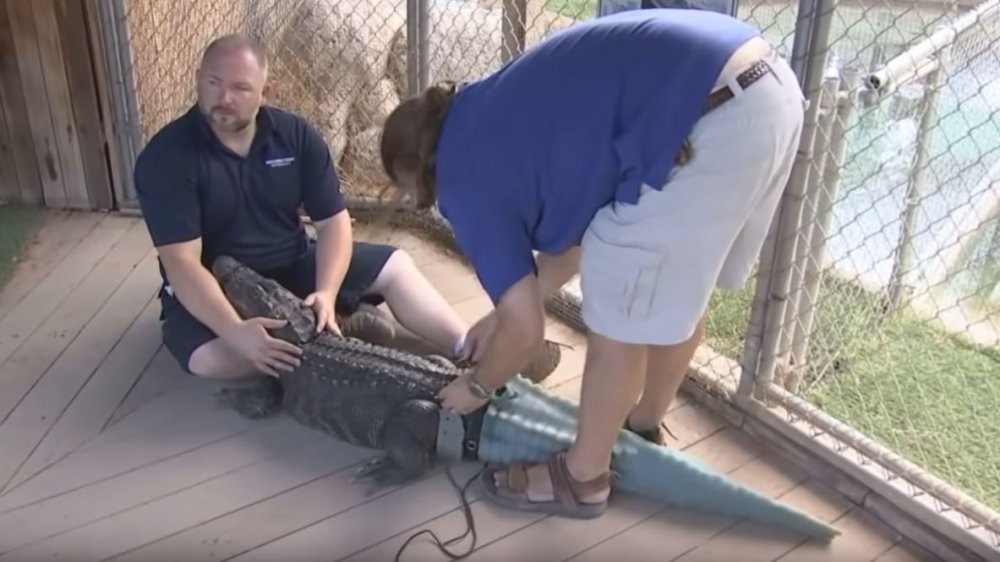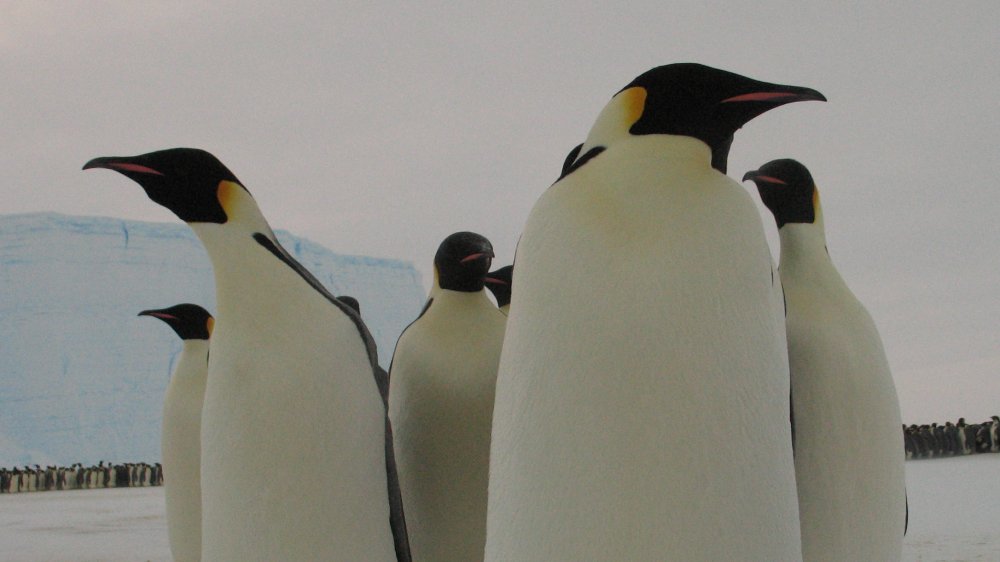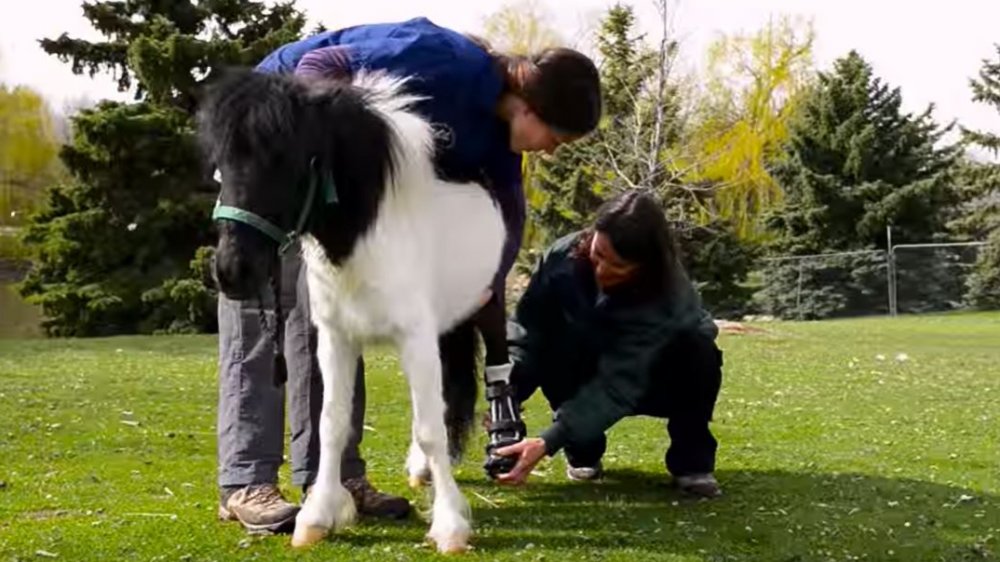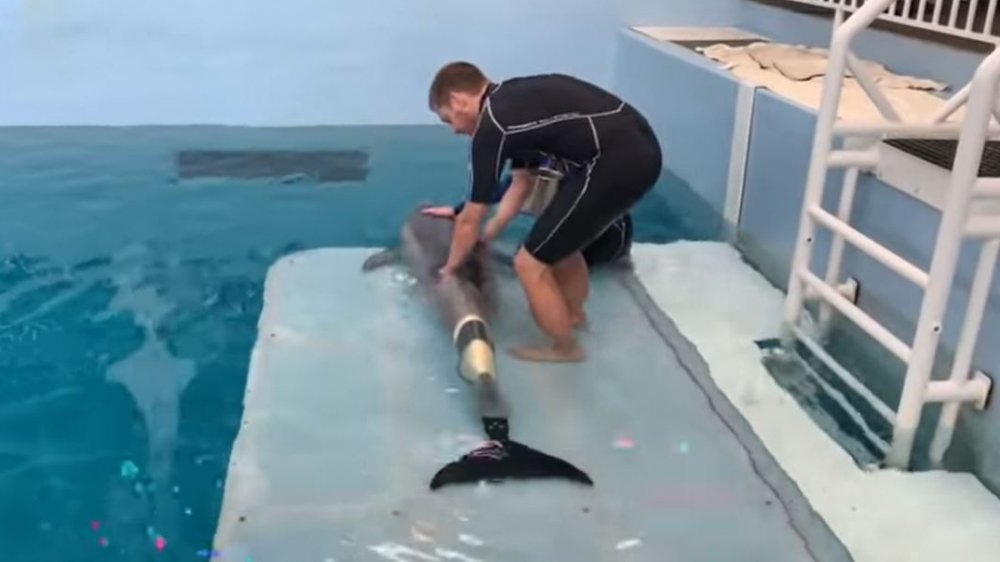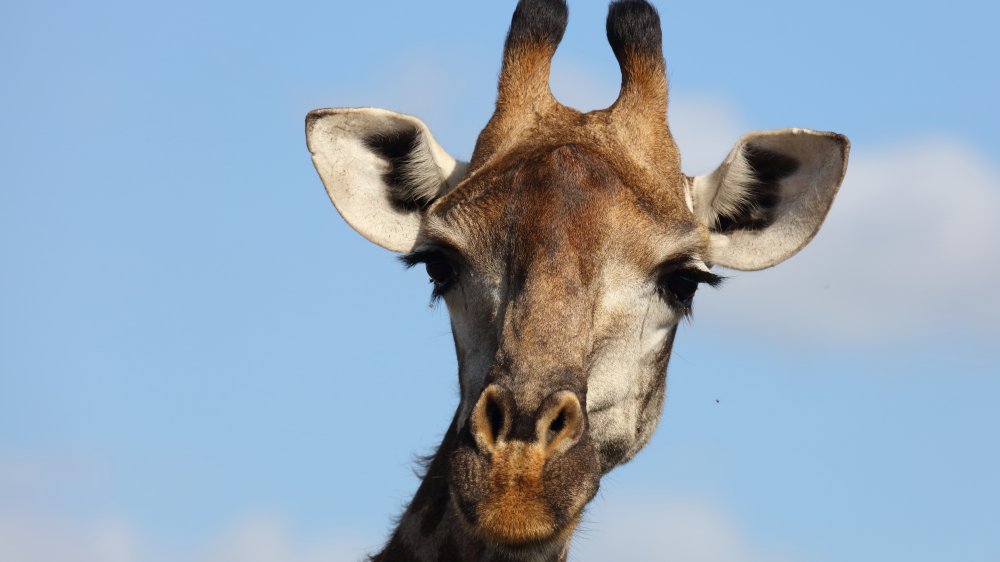Incredible Prosthetics That Gave These Animals A Second Chance
We can probably all agree that animals are wonderful and adorable. Unfortunately, much like us, they're also a part of the circle of life, which means that terrible things are going to happen to some of them. They get sick, and they get injured, and since an animal doesn't really have a way to bounce back from serious injury, losing the use of an important body part will make their lives very hard and, in all likelihood, very brief.
Fortunately, some of these sad stories have much happier endings. It turns out that lots of good people in this world have dedicated tons of time and effort to developing materials and techniques that enable our animal friends to live their best lives, even if they've lost the use of some crucial body parts. The field of animal prosthetics is thriving, and scientists are coming up with new, amazing inventions all the time. As such, there are many unfortunate animals that have managed to conquer their debilitating injuries with the help of their human friends. Let's take a look at some incredible prosthetics that gave badly injured animals a new lease in life.
Goody the sea turtle got a prosthetic flipper
Most turtles might be well-protected by their shells, but sea turtles tend to rely on their large flippers for transport, which leaves them exposed to several horrifying things, such as ... well ... us. As CBS News reports, this is precisely what happened to Goody, an olive ridley sea turtle who became trapped in a fishing net and lost one of her front flippers as a result. The poor animal was taken into captivity and was essentially immobile for years, but fortunately, science was able to pay back a little bit of what humanity had taken from her with a cool, new prosthetic flipper that enabled her to finally swim again.
In 2020, the environmental officials of Thailand collaborated with Chulalongkorn University to fit Goody with the new artificial flipper that helps her swim and generally improves her life, though it unfortunately doesn't enable her to survive in the wild. What's more, similar prostheses may be helping several other injured turtles in the future, and it looks like Thailand is far from the only country taking care of its injured reptiles. Though Goody was the first turtle in that particular country to score a space age flipper, other countries have been at it for years. For instance, CBS News tells us that in 2014, an Israeli team gave a turtle called Hofesh a similar prosthetic ... that they modeled after fighter jet wings. Nice.
Mosha, the elephant with an artificial leg
Elephants are creatures with near-human intelligence, and as you may have heard, they're fairly large and sturdy. Unfortunately, their sheer size means that if they receive a leg injury, they're in for a world of difficulty. Unfortunately, as ABC News tells us, humans are sometimes all too happy to hand out such injuries, as the seven-month-old Mosha the elephant found to her misfortune when she was wandering near the border of Thailand and Burma and stepped on a landmine. Mosha lost one of her front legs under the knee, and although she received permanent residency in a Thai animal hospital operated by the Friends of the Asian Elephant foundation, the situation seemed dire.
When she was injured, the elephant weighed "just" 1,300 pounds, but she was still growing. By 2016, she weighed an impressive 4,400 pounds, and as the Friends of the Asian Elephant website tells us, her growth spurts are still ongoing. This means her sheer mass puts incredible pressure on her spine and three working legs.
Fortunately, the good people at the hospital had a solution. Mosha became the first elephant in the world with a prosthetic leg, and as she continues to grow, the foundation designs new versions of the artificial limb to support her sheer size. They've gone as far as building a prosthesis factory in the hospital facility, and Mosha's caretaker and veterinarians keep a careful eye on her to ensure she doesn't suffer further injury.
The bald eagle with the 3D-printed beak
Bald eagles are majestic creatures, and according to Grist, they're also quite tenacious. So tenacious, in fact, that in 2005, one particular bald eagle survived getting shot in the face. Unfortunately, the poacher doing the shooting wounded the bird's beak so badly that she couldn't eat on her own. A group called Birds of Prey Northwest took the starving animal in, first tube-feeding her and later hand-feeding after she regained her strength. Well, forceps-feeding — after all, wounded or not, she was still a massive bird of prey.
However, it eventually became apparent that the bird, who they named Beauty, was in trouble. Her beak wasn't going to grow back, which meant she would always have to rely on outside help. Things might've ended very badly for poor Beauty if it wasn't for bird expert Jane Fink Cantwell and Nate Calvin of Kinetic Engineering Group. The two teamed up with a horde of experts to design and manufacture a 3D-printed nylon polymer beak that was a perfect replacement for Beauty's lost bits. Though the attachment process was described as "arduous," it was successful, and just like that, Beauty was back in the beak game.
Meet Oscar the bionic cat
As the BBC tells us, the story of Oscar the "bionic cat" started when the British cat's nap on a field was interrupted in the most horrible possible way — by a combine harvester. The machine sliced poor Oscar's back paws clean off, and by the time a passerby alerted the owners to the situation, the cat was "covered in blood [and] bits of flesh." It really, really didn't seem like the kind of story that would have a happy ending.
Yet, somehow, Oscar endured. Jersey's New Era Veterinary Hospital managed to stabilize Oscar's condition, and a vet hooked the cat's owners up with Noel Fitzpatrick, a veterinary surgeon and animal prosthetics pioneer. Fortunately, Oscar was a young and well-behaved animal, which made him the ideal candidate for a pioneering operation. In 2010, Fitzpatrick surgically attached new, custom-fitted implants to the cat's back feet. ABC News reports that the three-hour surgery was a roaring success, and Oscar was soon jumping and running around with very little trouble. What's more, the success of the operation bodes well for its potential uses in the future, and eventually, a similar process may even be used on humans.
Naki'o the dog finds his feet
To say that Naki'o had a bad start in life is an understatement. As ABC News reports, the poor dog was only a puppy when he was found frozen into a puddle in an ice-cold cellar of an abandoned house. Frostbite took the tip of his tail and all of his paws, and there's no telling what would have happened to the pawless, homeless dog if it wasn't for veterinarian assistant Christie Pace.
Determined to offer the dog a new lease in life, Pace took Naki'o in and managed to raise enough money to afford prosthetics for Naki'o's hind legs, which worked well enough. When the manufacturer saw how much the dog was struggling with his front legs, they decided to make him front leg prostheses for free. And that's how in 2011, Naki'o received new feet and could finally play fetch and run around as much as he pleased. As an added bonus, he also became somewhat famous, as the "groundbreaking" case astonished everyone in veterinary circles.
Girl the tiger and her artificial hip
Arthritis and artificial hips seem like something that your elderly relatives might suffer from. However, joint inflammation is by no means exclusive to humans, as evidenced by Girl the tiger, who The Guardian tells us received her very own hip replacement in 2011. Girl, an eight-year-old Malayan tiger residing in the German Halle Zoo, had developed a nasty case of arthritis in her right hip, and as she's a member of one of the world's endangered species, keeping her in good condition was obviously a priority for everyone involved. So, it was tiger hip replacement time.
In what experts believed was the first operation of its kind, a team of veterinarians from the University of Leipzig performed the complex, three-hour operation using a type of hip joint prosthetic that was originally developed for dogs. The procedure was not without its dangers, and at one point, Girls' heart nearly stopped. However, the anesthesiologist managed to save her, the operation was a success, and Girl returned to the zoo with a brand new hip.
An amputee kangaroo gets a second chance
If there's one animal that it's borderline impossible to imagine with a leg prosthetic, it has to be a kangaroo. After all, they heavily rely on their famously powerful legs, and even more importantly, they only have two of them. Could a kangaroo even jump around with a leg prosthetic, let alone survive on one limb? According to The Lantern, it's possible — at least, provided that the caretakers of the kangaroo refuse to take "no" for an answer.
When the International Kangaroo Society took Stumpy the red kangaroo in its Lancaster, Ohio, sanctuary, the large animal was already an amputee. Unwilling to accept the animal's likely grim future, the sanctuary runners contacted Dr. David E. Anderson of the College of Veterinary Medicine and prosthesis expert Richard Nitsch, who teamed up to set poor Stumpy back on her feet. In a 90-minute procedure, Anderson fixed the amputation in a way that enabled the fitting of a foot prosthesis. Then, Nitsch fitted Stumpy with a spring-equipped athlete's prosthesis (much like the ones worn by amputee runners). This ingenious tag-team work enabled Stumpy to jump around much like a regular kangaroo and lead a somewhat normal life, to the point that she could even have baby kangaroos.
Mr. Stubbs the alligator has a prosthetic tail
As National Geographic informs us, Mr. Stubbs wasn't the luckiest alligator in the world. Not only was he a victim of an animal trafficking ring, but he lost his tail when they were transporting him. This was a big deal, seeing as the tail comprises a pretty significant chunk of the animal and, as Live Science notes, they use it to swim.
Fortunately, Mr. Stubbs' fortunes turned in 2013, when the Phoenix Herpetological Society took him under their wing and started experimenting with prosthetic tails. Mr. Stubbs' first prosthetic was made using a cast of another alligator of similar size. This didn't work well because alligators have body types, too, so assorted differences in buoyancy and center of mass made the tail fairly clumsy. Not that Mr. Stubbs had to endure it for long, as he was a growing gator and his caretakers had to keep coming up with new prostheses that accommodated his size.
In 2018, after five years of prosthetics of varying clunkiness, anatomy expert Justin Georgi of Midwestern University, who'd been involved with the construction of several tails, finally decided to go all in. He joined forces with a master's student and a local 3D printing company to craft Mr. Stubbs a state-of-the-art, 3D-printed tail that was customized down to "below the millimeter scale." Mr. Stubbs seemed to like the new tail, and he used it so well that he actually tail-slapped a volunteer worker. Gratitude!
Penguins with prosthetic beaks and feet
Penguins are adorable, but let's be honest. Unless you're a fish, they seem pretty fragile. In other words, being a penguin can suck. Fortunately, people who make animal prosthetics have recognized the whole "waddling mass of feathers" situation the ol' tuxedo birds are rocking, and they've reacted the only way they know how. Awesomely.
As CNET tells us, the Warsaw Zoo in Poland figured out the art of penguin saving in 2014, when one of their African penguin wards broke its lower beak. Thanks to the magic of 3D scanning and printing, he received a cool, artificial replacement and was able to go about his life. In 2016, the BBC reported new, even more interesting developments on the field of printer-enabled penguin saving. Bagpipes, the adorably named New Zealand penguin, had become entangled in a fishing line and lost his leg as a result. He spent a challenging nine years limping around, until Don Clucas of the University of Canterbury was finally able to come up with a new, 3D-printed prosthetic leg. Which must have been a relief to all involved, seeing as up to that point, the penguin's keeper had been forced to build Bagpipes leg supports from foam beer bottle holders.
A mini horse gets a second chance and a new hoof
What's more adorable than a miniature horse? Well, as ABC News tells us, a miniature horse that overcomes all odds and still continues to be adorable. Such is the case with Shine, the "little pony that could." The nickname is extremely apt because Shine lost a leg yet kept on going. For a horse, this is particularly amazing, because losing a leg is pretty much "the end" for them. As Science ABC notes, if a horse breaks its leg, it's often put down because the healing process is extremely difficult. What's more, keeping a horse still during the healing process is hugely risky because their blood circulation essentially depends on their hooves.
Shine didn't know any of this, but even if he did, he likely wouldn't have cared. When his leg was badly maimed by what was believed to be a dog in December 2015, he endured. When the wound became infected, he endured. Of course, he had luck on his side, as well. Being a mini horse, he was deemed tiny enough for both an amputation and a cool, new hoof prosthetic, an operation which he of course endured. Not that the recovery process was easy, as he initially disliked the strange new thing strapped to his leg and tried to chew it off. Fortunately, physical therapy helped him to start adjusting to his new situation, and today, he appears to be walking just fine.
The tail of Winter the dolphin
Sometimes, you can help thousands of people and one animal, and the animal is all everyone remembers you for. As USA Today reports, this is the case with prosthetics and rehabilitation expert Dan Strzempka, who estimates having helped around 10,000 people with their lost appendages. However, he and colleague Kevin Carroll truly made their name because of an Atlantic bottlenose dolphin called Winter.
In December 2005, a three-month-old Winter lost her entire tail fluke in a crab trap. She needed a prosthetic and needed it fast, as her health was getting worse. Strzempka, an amputee himself, had only worked with humans up to that point, but when Carroll told him about the case, they jumped right in. Together with a team of dolphin experts, the two managed to design a prototype tail in around five weeks. They were initially worried that Winter wouldn't accept it, but she seemed to realize the humans were trying to help and was perfectly fine with her new prosthetic. In the process, Strzempka and Carroll invented a new type of skin-protecting gel that many amputees use even today.
The story was eventually adapted into a movie called Dolphin Tale, where Morgan Freeman plays a fictionalized version of the Strzempka-Carroll team.
Prosthetics helped Jenna the giraffe survive a life-threatening injury
Giraffes are mostly neck and legs, and you'd imagine that they would be in some spectacular trouble if they damaged any of these appendages. However, it turns out that giraffes can — and absolutely do — get on just fine with some pretty hefty leg damage. All they need are some human friends and creative prosthetics.
As WSFA tells us, it was 2010, and Jenna the giraffe at Alabama's Montgomery Zoo got spooked in her enclosure and broke several bones in her leg. This made a particular tendon contract, which in turn forced her to walk tippy-toed (tippy-hooved?) on that particular leg. Giraffes usually have to be put down after this sort of damage, but fortunately, Alabama was able to put its brightest prosthetic-themed minds on the job. A ground-breaking collaboration between Auburn University College of Veterinary Medicine and Hanger Prosthetics was able to build a brace, which helped Jenna with her leg trouble and marked the first time in history where a captive giraffe with an injury like this had been able to survive. Though Jenna likely has to wear the brace for the rest of her life and experts constantly monitor her for any signs of pain, as of 2017, she was expected to have two more decades of perfectly happy giraffe life ahead of her.
